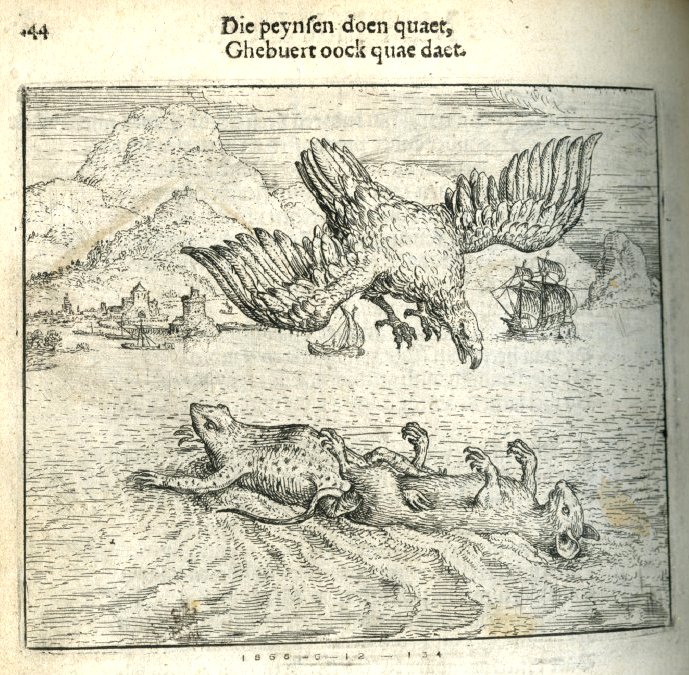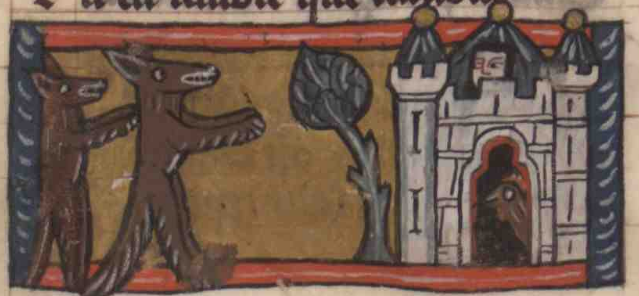- Download:
- MP3 Audio87 MB
This episode, we turn to another genre of wisdom literature: the fable. We look at four versions of the fable of the Mouse and the Frog from across one-and-a-half millennia, with quasi-classical versions from the Vita Aesopi and the Romulus Aesop and medieval elaborations on the story by Marie de France and Robert Henryson.
Today’s Texts:
- Life of Aesop. Translated by Anthony Alcock, Roger-Pearse.com, 4 Aug. 2018, https://www.roger-pearse.com/weblog/2018/08/14/life-of-aesop-translated-by-anthony-alcock/.
- “The Mouse and the Frog.” The Comedies of Terence and The Fables of Phædrus, translated by Henry Thomas Riley, George Bell & Sons, 1891, p. 456. Google Books.
- Marie de France. “The Mouse and the Frog.” The Fables of Marie de France, translated by Mary Lou Martin, Summa Publications, 1984, pp. 36-42.
- Henryson, Robert. “The Taill of the Paddok and the Mous.” The Poems and Fables of Robert Henryson, edited by David Laing, William Paterson, 1865. Google Books.
References:
Adrados, Francisco Rodríguez. History of the Graeco-Latin Fable. Translated by Leslie A. Ray, vol. 1, Brill, 1999.
Daly, Lloyd W., translator and editor. Introduction. Aesop Without Morals, Thomas Yoseloff, 1961, pp. 11-26.
Fox, Denton, editor. The Poems of Robert Henryson. Clarendon Press, 1981.
Kiser, Lisa J. “Resident Aliens: The Literary Ecology of Medieval Mice.” Truth and Tales: Cultural Mobility and Medieval Media, edited by Fiona Somerset and Nicholas Watson, Ohio State UP, 2015, pp. 151-167. Academia.edu, www.academia.edu/11171687/Resident_Aliens_The_Literary_Ecology_of_Medieval_Mice.
- Jacobs, Joseph. The Fables of Aesop. Vol. 1, History of the Æsopic Fable, 1889, Burt Franklin, 1970.
- Mann, Jill. From Aesop to Reynard: Beast Literature in Medieval Britain. Oxford UP, 2009.
- Martin, Mary Lou. Introduction. The Fables of Marie de France, translated by Mary Lou Martin, Summa Publications, 1984, pp. 1-30.
- O’Connor, Flannery. “Writing Short Stories.” Mystery and Manners, FSG, 1970, pp. 87-106.
- Skillen, Anthony. “Aesop’s Lessons in Literary Realism.” Philosophy, vol. 67, no. 260, Apr. 1992, pp. 169-181. JSTOR, www.jstor.org/stable/3751449.[Greek text of the fable in the Vita Aesopi, Ch. 21:]Vita Aesopi. Edited by Antonius Westermann, Williams and Norgate, 1845, p. 54. Google Books. [Romulus Latin Text in:]”Mus et Rana.” Phaedri Fabularum Aesopiarum libri quinque, quales omni parte illustratos publicavit Joann. Gottlob. Sam. Schwabe. Accedunt Romuli Fabularum Aesopiarum libri quatuor, quibus novas Phaedri Fabellas cum notulis variorum et suis subjunxit, edited by J. B. Gail, vol. 2, 2nd ed., N.E. Lemaire, 1826, p. 386. Google Books.
Music by Chris Lane.
Image: Illustration by Marcus Gheeraerts the Elder (1567), from The British Museum via Wikimedia Commons (CC BY-SA 4.0).





Recent Comments